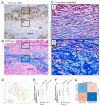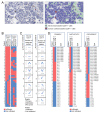Dynamic Changes in the Extracellular Matrix in Primary, Metastatic, and Recurrent Ovarian Cancers
- PMID: 36497028
- PMCID: PMC9736731
- DOI: 10.3390/cells11233769
Dynamic Changes in the Extracellular Matrix in Primary, Metastatic, and Recurrent Ovarian Cancers
Abstract
Cancer-associated fibroblasts (CAFs) and their extracellular matrix are active participants in cancer progression. While it is known that functionally different subpopulations of CAFs co-exist in ovarian cancer, it is unclear whether certain CAF subsets are enriched during metastatic progression and/or chemotherapy. Using computational image analyses of patient-matched primary high-grade serous ovarian carcinomas, synchronous pre-chemotherapy metastases, and metachronous post-chemotherapy metastases from 42 patients, we documented the dynamic spatiotemporal changes in the extracellular matrix, fibroblasts, epithelial cells, immune cells, and CAF subsets expressing different extracellular matrix components. Among the different CAF subsets, COL11A1+ CAFs were associated with linearized collagen fibers and exhibited the greatest enrichment in pre- and post-chemotherapy metastases compared to matched primary tumors. Although pre- and post-chemotherapy metastases were associated with increased CD8+ T cell infiltration, the infiltrate was not always evenly distributed between the stroma and cancer cells, leading to an increased frequency of the immune-excluded phenotype where the majority of CD8+ T cells are present in the tumor stroma but absent from the tumor parenchyma. Overall, most of the differences in the tumor microenvironment were observed between primary tumors and metastases, while fewer differences were observed between pre- and post-treatment metastases. These data suggest that the tumor microenvironment is largely determined by the primary vs. metastatic location of the tumor while chemotherapy does not have a significant impact on the host microenvironment.
Keywords: CAF; COL11A1; ECM; carcinoma-associated fibroblasts; collagen; computational imaging; extracellular matrix; high-grade serous ovarian cancer; tumor microenvironment.
Conflict of interest statement
The authors declare no conflict of interest. The funders had no role in the design of the study; in the collection, analyses, or interpretation of data; in the writing of the manuscript; or in the decision to publish the results.
Figures






References
-
- Desbois M., Udyavar A.R., Ryner L., Kozlowski C., Guan Y., Dürrbaum M., Lu S., Fortin J.P., Koeppen H., Ziai J., et al. Integrated digital pathology and transcriptome analysis identifies molecular mediators of T-cell exclusion in ovarian cancer. Nat. Commun. 2020;11:5583. doi: 10.1038/s41467-020-19408-2. - DOI - PMC - PubMed
-
- Mariathasan S., Turley S.J., Nickles D., Castiglioni A., Yuen K., Wang Y., Kadel Iii E.E., Koeppen H., Astarita J.L., Cubas R., et al. TGFbeta attenuates tumour response to PD-L1 blockade by contributing to exclusion of T cells. Nature. 2018;554:544–548. doi: 10.1038/nature25501. - DOI - PMC - PubMed
-
- Tauriello D.V.F., Palomo-Ponce S., Stork D., Berenguer-Llergo A., Badia-Ramentol J., Iglesias M., Sevillano M., Ibiza S., Canellas A., Hernando-Momblona X., et al. TGFbeta drives immune evasion in genetically reconstituted colon cancer metastasis. Nature. 2018;554:538–543. doi: 10.1038/nature25492. - DOI - PubMed
-
- Grauel A.L., Nguyen B., Ruddy D., Laszewski T., Schwartz S., Chang J., Chen J., Piquet M., Pelletier M., Yan Z., et al. TGFβ-blockade uncovers stromal plasticity in tumors by revealing the existence of a subset of interferon-licensed fibroblasts. Nat. Commun. 2020;11:6315. doi: 10.1038/s41467-020-19920-5. - DOI - PMC - PubMed
-
- Salmon H., Franciszkiewicz K., Damotte D., Dieu-Nosjean M.C., Validire P., Trautmann A., Mami-Chouaib F., Donnadieu E. Matrix architecture defines the preferential localization and migration of T cells into the stroma of human lung tumors. J. Clin. Investig. 2012;122:899–910. doi: 10.1172/JCI45817. - DOI - PMC - PubMed
MeSH terms
Grants and funding
LinkOut - more resources
Full Text Sources
Medical
Research Materials
Miscellaneous

